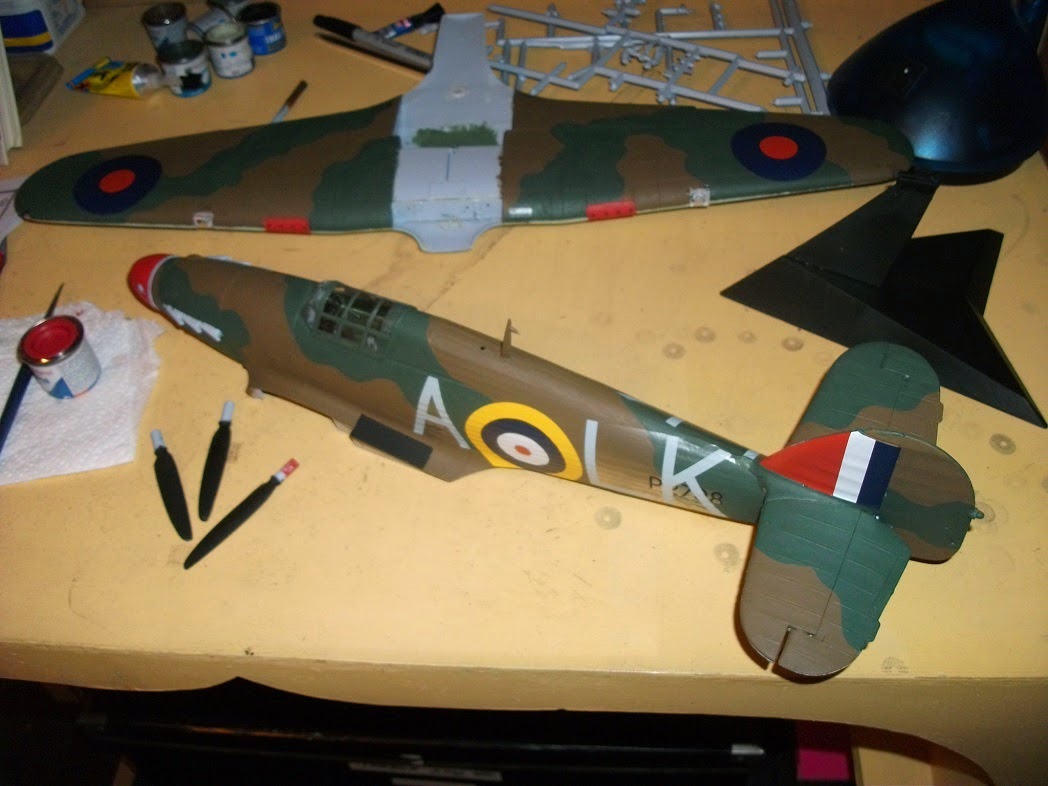Last November I wrote about the gay Battle of Britain fight pilot Squadron Leader Ian Gleed. I also told you about the plastic model kit I was putting together of one of Gleed’s aircraft, the Hawker Hurricane Mk1. I’ve not been rushing to complete it and its still not finished (photo below). The internet is full of forums where others have been making this model.
With the airplane being
one of the very few commercially available model kits which is of a plane flown
by a specific fighter pilot, and certainly only one of the two I know about
(there’s also a model kit of Gleed’s Spitfire), I thought I’d have a look at
his association with the Hawker Hurricane and how it helped him to become a war
hero.
Acting Flight Lieutenant
Ian Gleed acquired the specific plane reproduced in the model kit on 17th
May 1940 shortly after he arrived at 87 Squadron’s base near Lille in France.
The Hawker Hurricane Mk1 was one of the most reliable and rugged fighter planes
in the RAF. Gleed had his Hurricane painted in standard camouflage with the
squadron’s code letter LK and the individual plane letter A.
Wartime pilots often
adopted lucky mascots. Ian Gleed’s mascot was the cartoon cat called Figaro
from the Disney film “Pinocchio” which had recently been released. You can’t
see it on the photo above but it was painted on the other side of the plane on
the detachable cockpit door. This mascot was painted on all of the subsequent
planes Gleed flew as well. The picture below (by “stickman” on www.a2asimilations.com) shows Figaro
swatting a swastika with his paw, the usual pose Gleed used for his mascot and
it proved so distinctive that the Hurricane soon gained the nickname “Figaro”.
Another distinctive paint
job on “Figaro” was the propeller cone. It was painted red, and the very front
of the fuselage was painted with a pair of red lips so that it looked as though
“Figaro” was blowing a raspberry at Nazi enemy planes.
Gleed’s first day of
operations in his new plane was the following morning, 18th May, as
leader of a dawn patrol over the French/Belgian border. They encountered 5 Nazi
Messerschmitts and immediately engaged them. Gleed shot down 2 of them. That
was just the start of an intense period. He shot down another 6 enemy planes
over the next 2 days.
87 Squadron was based in
France until the advance of Nazi troops came too close and the pilots were
ordered to evacuate back to England. In the ten days that the squadron fought
the attacks on the ground and in the air some 70 Nazi planes was shot down, at
least. Pilots and civilians were killed. It was safer for the British pilots to
be brought home. Besides, a much bigger battle was on the way, and Britain
needed as many pilots as it could muster.
As second in command of
the squadron Gleed became the force behind rebuilding the team and morale.
Stationed in the south of England they encountered sporadic night raids which
increased over several weeks. Many Nazi planes were shot down and several 87
Squadron pilots were lost in battle. This was the prelude to the Battle of
Britain.
Taking to his “Figaro”
plane many times over the next months as the Battle of Britain raged on Gleed
shot down 7 Nazi planes. For his actions Gleed was awarded the Distinguished Flying
Cross. At the end of September 1940 he was promoted to Squadron Leader with
full command of 87 Squadron.
During 1941 Gleed
continued to take to the air in “Figaro” to engage enemy raiders. The main duty
of 87 Squadron at this time was in night flying, so “Figaro” was painted black.
Gleed flew over London during one of the most intensive nights of the blitz.
On promotion to Wing
Commander in November 1941 Ian Gleed left 87 Squadron and his loyal companion
of the sky “Figaro”. It had been developing mechanical problems over the
previous months and had not flown in it since August. Gleed had to leave
“Figaro” behind with the squadron, for from now on he’d be flying mostly in the
iconic plane of Fighter Command, the Spitfire. “Figaro” was decommissioned, and
after Gleed was shot down and killed in 1942 his family was given the cockpit
door of “Figaro” with Figaro the cat (the very one in the photo above). This is
now in the RAF Museum collection.



No comments:
Post a Comment